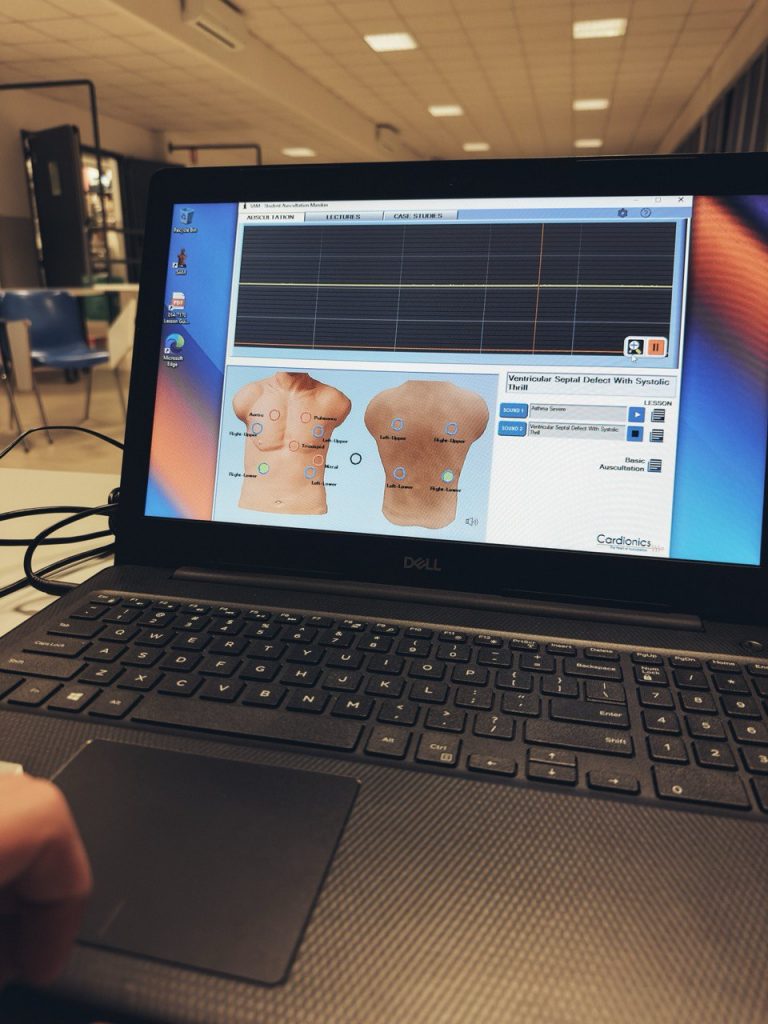SAM 3G® is definitely a very valuable advanced skill trainer for all healthcare professions where auscultation is crucial. Here’s what our simulation technician has to say about it
Among the priority skills to be learnt by a medical student, the initial recognition of certain cardiac, pulmonary and intestinal diseases is certainly indispensable. It is obviously necessary to practise in order to sharpen one’s ear. This is usually done directly in hospital clinical departments on real patients or, within universities, by involving volunteers, who are mostly, however, healthy subjects, so pathological sounds are missed.
Cardionics’ SAM 3G, distributed in Italy by 3BScientific SRL, whom we thank for the loan in order to write this review, is designed to amply compensate for the aforementioned lack.

Hardware
The simulator comes with a torso, without limbs, which can be fully auscultated through a standard phonendoscope, without the need for additional adapters.
The construction of the manikin is excellent and looks quite durable.
At the base are the ports necessary for operation, namely 2 USB-B inputs for connection to the control computer, power supply and ON-OFF button.
Software
Obviously a fundamental part of the simulator is the software, which is generally very intuitive. The various functions and modes of use are well divided into three panels:
- Auscultation
- Lectures
- Case Studies
Auscultation
Within this panel it is possible to select the different sounds available within the software, being able to choose not only between the different districts (heart, lungs, intestines) but also the quality of the sound, i.e. whether simulated or real.
This panel is in turn divided into three parts:
- Phonocardiogram
- Images of the manikin’s torso (front and back) with auscultatory positions
- Panel dedicated to the choice of pathology, i.e. sound.

Case Studies
This panel contains a list of cases with a video and the patient’s medical record attached.
This is meant to illustrate doctor-patient communication.
As in the previous section, there is a representation of the manikin and auscultation positions. Selecting one of the icons on the torso activates the sound and the corresponding phonocardiogram.
Lectures
This section allows you to create and edit lectures, being able to note down the instructor’s name, the title of the lecture and the various scenarios that are represented by the different sounds in this device.
Student mode
Various features can be switched on and off within SAM:
- Title sounds and case studies
- Restrict access to volume controls
- Hide the phonocardiogram
- Block the possibility of editing lessons and cases

The verdict
Overall the manikin is very robust and of very good quality, the same cannot be said of the software as it is as intuitive as it is aesthetically backward. Thanks to the quantity and quality of the sounds, including the corresponding phonocardiograms, 12 echocardiogram videos and, above all, the fact that it is not an exclusively cardiological simulator, the SAM 3G is certainly a very valid advanced skill trainer for all healthcare professions in which auscultation is fundamental.

- Excellent manikin material
- Extensive and up-to-date sound compartment
- Three distinct exercise sections
- Use of a real phonendoscope
- Not only cardiological

- Slightly ‘cheap’ manikin base
- Overall a functional simulator, but perhaps a little vintage
- Software technically and aesthetically out of date
Antonio Scalogna










































